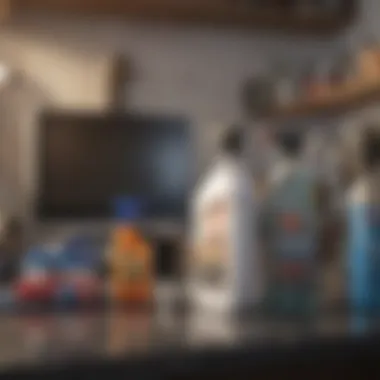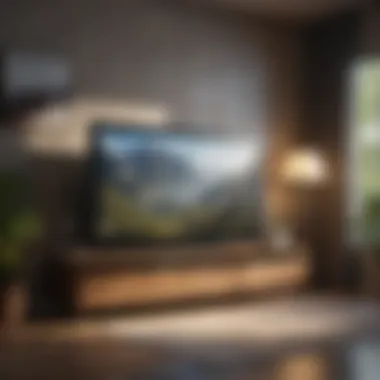Efficient Methods for Cleaning TV Screen Smudges


Intro
Cleaning television screens effectively is more important than many realize. With high-definition displays now commonplace, keeping these screens free from smudges and fingerprints directly impacts viewing experience. Smudges can blur images and make colors appear less vibrant. Understanding the right methods and materials for cleaning television screens helps in maintaining visual clarity.
In this guide, we will delve into safe cleaning techniques and tools to avoid damaging the screen. We aim to dispel common misconceptions concerning screen maintenance. The following sections will cover everything from necessary materials to detailed cleaning techniques and preventive measures.
Key Points to Explore
- Materials to Use: Discussing suitable cleaning cloths and liquid solutions.
- Safe Techniques: Highlighting effective cleaning methods.
- Preventive Measures: Suggesting ways to reduce future smudges.
This comprehensive approach will ensure your television screen remains pristine, enhancing your viewing experience significantly.
Understanding Television Screen Types
Understanding the various types of television screens is fundamental when discussing efficient cleaning methods for smudges. Each screen type has distinct characteristics that can influence cleaning techniques, solutions, and requirements for maintenance. Misunderstanding these differences can lead to undesired outcomes, such as screen damage or ineffective cleaning results. Moreover, awareness of screen types helps users select the right materials and approaches tailored for their television, ensuring a long lifespan and optimal viewing quality.
Screens
LCD, or Liquid Crystal Display, screens are commonly found in many modern televisions. They utilize liquid crystals sandwiched between layers of glass or plastic to produce images. When it comes to cleaning LCD screens, caution is necessary. They can be sensitive to harsh chemicals and abrasive materials. To clean LCD screens effectively, it is advisable to use a soft, lint-free microfiber cloth slightly dampened with distilled water. This method minimizes the risk of scratches and preserves the screen's functionality.
LED Screens
LED, or Light Emitting Diode, screens are technically a type of LCD screen that uses LEDs for backlighting. The cleaning approach for LED screens aligns closely with that of LCD screens. Using a microfiber cloth is crucial, as it gently removes smudges without causing damage to the screen. For better results, a tested cleaning solution formulated specifically for electronic screens can be applied sparingly. LED screens, while offering superior brightness and color contrast, still require gentle care during cleaning.
OLED Screens
OLED stands for Organic Light Emitting Diode, a modern technology that allows each pixel to emit its light. These screens offer remarkable contrast and color depth but also require specific cleaning methods. Touching an OLED screen can lead to unsightly fingerprints. Cleaning this type demands extra attention to avoid any damage to the thinner panel. A microfiber cloth, slightly dampened, should be used to clean OLED screens. Users should steer clear of alcohol-based cleaners which could dismantle the organic layers and affect the screen's performance.
Plasma Screens
Plasma screens, though less common now, were known for their vibrant colors and deep blacks. Cleaning plasma screens involves similar precautions as with OLED screens. The surface of plasma screens is susceptible to scratches and can hold onto dust and smudges. Therefore, wiping with a dry microfiber cloth is often best for maintenance. If more intensive cleaning is necessary, a slightly dampened cloth can be utilized, but care should be taken not to leave moisture on the surface.
Understanding these screen types is essential for anyone looking to maintain their television. Missteps in cleaning procedures can lead to unsatisfactory results, further smudges, or even damage. Taking the time to grasp the specifications of each screen type will ensure designs remain visually appealing and operational.
Why Smudges Occur
Understanding why smudges occur on television screens is essential for effective cleaning. Smudges can distract from the viewing experience and detract from the quality of the display. By recognizing the sources of these marks, individuals can take preventive measures. Additionally, this understanding aids in selecting appropriate cleaning strategies and ensuring the longevity of the screen.
Oil and Fingerprints
Most smudges originate from oils and fingerprints. The human skin releases natural oils, which easily transfer to surfaces like television screens. Each time we touch the screen, either intentionally or inadvertently, these oils accumulate, creating visible marks. The combination of oils and dust also creates a sticky surface that attracts more particulate matter, leading to a persistent dirty appearance. Recognizing this phenomenon is crucial as it highlights the need for regular screen cleaning to maintain optimal viewing conditions.
Dust and Particles
Dust and tiny particles are also major contributors to screen smudging. Environments with low humidity and higher traffic, such as living rooms or offices, often see more dust accumulation. The dust can settle on screens over time, and when someone touches the screen, it compounds the problem. Frequent cleaning can help alleviate this issue, but understanding the environment where the television is located can also inform better dust management practices. By keeping the area around the television clean, one can minimize the frequency and severity of smudges.
Cleaning Products Residue
Another often-overlooked source of smudges is the residue left behind by cleaning products. Many commercial cleaning solutions contain chemicals that can leave sticky residues or films that attract dust and dirt. When these residues accumulate, they can create an appearance similar to smudges, leading users to clean their screens more frequently than necessary. It is critical to use appropriate cleaning solutions and ensure a thorough wipe to avoid this issue. Selecting a cleaning product designed specifically for screens can reduce the risk of residue buildup, thus enhancing the cleaning process.
Essential Tools for Cleaning
Cleaning a television screen requires more than just a casual approach. The right tools are essential to effectively and safely remove smudges without damaging the screen. Utilizing appropriate equipment ensures that cleaning becomes not only efficient but also maintains the quality of the screen. This section will emphasize important tools that contribute to a successful cleaning process.
Microfiber Cloths


Microfiber cloths are the cornerstone of any effective screen cleaning kit. Their unique fabric structure traps dust, dirt, and oils without scratching the surface of the screen. This is crucial because many traditional cloths can leave behind lint or, worse, cause scratches.
When selecting a microfiber cloth, it is important to choose one that is soft and non-abrasive. These cloths are washable and reusable, which makes them both economical and environmentally friendly. They also allow for a streak-free finish that enhances viewing quality. Choosing a high-quality microfiber cloth is an investment in the longevity of a television.
- Always use a clean cloth to avoid transferring dirt back onto the screen.
- Store cloths in a dust-free container to maintain cleanliness.
Screen Cleaning Solutions
Screen cleaning solutions are specifically formulated to clean screens without harming them. Many common household cleaners contain alcohol or ammonia, which can cause irreversible damage to television screens. A dedicated screen cleaner usually contains mild solvents and is safe for all types of screens.
It is advisable to check product labels carefully. Solutions that are alcohol-free and have pH-balanced formulas are generally the safest choice. Using the right cleaner will enhance the efficiency of the cleaning process, making it easier to remove tough smudges.
- Look for products from reputable manufacturers.
- Test the solution on a small, inconspicuous area before full application.
Distilled Water
Distilled water can serve as an effective, simple cleaning solution when combined with microfiber cloths. Unlike tap water, distilled water is free from impurities and minerals that may cause streaks or cloudiness on the screen. Mixing distilled water with a mild screen cleaner can enhance cleaning results without introducing harmful chemicals.
Using distilled water is a practical choice for those who prefer a more natural cleaning method. It is often a safer alternative for sensitive surfaces, ensuring that screens remain in good condition over time.
- Always use distilled water rather than regular water.
- Store distilled water properly to prevent contamination.
Investing in quality tools for screen cleaning not only improves the cleaning process but significantly prolongs the lifespan of your television.
Cleaning Methodologies
The way you clean your television screen matters significantly. Cleaning methodologies refer to the various techniques used to remove smudges, dust, and fingerprints from screens. Selecting the right method can enhance cleaning efficacy while also protecting the screen's integrity. This section will discuss different approaches to cleaning television screens, covering their advantages and what to consider for optimal results.
Dry Cleaning Approach
The dry cleaning method is simple and effective for light smudges. This technique involves the use of a soft, microfiber cloth. The cloth should be free from any abrasive material to prevent scratching the screen. The primary benefit of dry cleaning is that it avoids the complications of moisture, which can be damaging to electronic devices.
To effectively use the dry cleaning approach:
- Always ensure the cloth is clean and dry before use.
- Gently wipe the screen in a circular motion. This helps lift dust and light smudges without spreading them.
- Avoid pressing too hard on the screen; gentle strokes are sufficient.
Wet Cleaning Technique
The wet cleaning technique is suitable for removing persistent stains and fingerprints that dry cleaning cannot tackle. This method utilizes a damp microfiber cloth, often combined with a specific screen cleaning solution or a mixture of distilled water and vinegar.
When using the wet cleaning technique, consider the following:
- Always spray the cleaning solution on the cloth first, never directly onto the screen. This helps prevent excess moisture from seeping into the device.
- Wipe the screen gently using vertical and horizontal strokes. This ensures even cleaning and reduces streaks.
- After cleaning, it is vital to dry the screen with a soft, dry cloth.
This method allows for thorough cleaning without risking screen damage when done correctly.
Using Screen Solutions
Screen solutions designed specifically for televisions often contain safe ingredients that effectively eliminate smudges without harming the screen’s surface. The advantage of these specialized solutions is that they are formulated to be compatible with various screen types, including LCD, LED, and OLED displays.
Effective use of screen cleaning solutions involves:
- Selecting a product that specifies compatibility with your screen type.
- Following the manufacturer’s instructions for application. This usually involves applying a small amount of solution to a microfiber cloth.
- Ensuring the cloth is only lightly dampened, as excess liquid can be damaging.
Utilizing these solutions can significantly improve cleaning outcomes by removing stubborn residues while maintaining screen clarity and quality.


In summary, understanding the various cleaning methodologies will aid in maintaining your television screen, preserving not only its appearance but also its longevity. By being mindful of the techniques and products used, enthusiasts can ensure that their viewing experience remains optimal.
Steps for Effective Cleaning
Cleaning smudges off television screens is not merely a superficial task; it impacts both the appearance and longevity of your device. A clear display enhances viewing pleasure, making shows and movies more enjoyable. In addition, improper cleaning can lead to damage. Therefore, understanding the steps for effective cleaning is essential. This section will explore vital elements involved in ensuring a seamless cleaning process.
Preparation
Before embarking on the cleaning process, proper preparation is crucial. Begin by gathering all necessary materials, such as a microfiber cloth, the chosen cleaning solution, or distilled water. It is important to ensure the screen is turned off to avoid potential damage or shocks.
A clean workspace is also advisable. Clear any items around the television that may obstruct your access, and ensure there is good lighting to see the smudges clearly. This preparation will facilitate a smoother experience, making the cleaning process more effective.
Application of Cleaning Solution
Once you complete the preparation phase, you can proceed with the application of the cleaning solution. It is essential to never apply the solution directly onto the screen, as this can lead to liquid seeping into the edges and causing internal damage. Instead, lightly spray the solution onto the microfiber cloth.
Most cleaning solutions are designed for screen use, but some household items such as a vinegar and water mixture work, too. Ensure the cloth is damp, not soaking. This keeps any excess fluid from being an issue. Carefully test the solution on a small area first, ensuring it does not damage any coatings present on the screen.
Wiping Technique
The method of wiping is often overlooked but is fundamental for effective cleaning. Use gentle, circular motions while wiping the screen. This helps to lift off dirt and smudges without scratching the surface. It is also wise to avoid excessive pressure that can cause damage.
While working from top to bottom, ensure you cover the entire surface. If any areas remain smudged, repeat the wiping technique only on those spots rather than going over the entire screen multiple times. This will keep your cleaning efficient and reduce the risk of streaks appearing.
Drying Process
After the screen has been wiped down, addressing the drying process is essential. Allow the screen to air dry naturally for a few moments before turning it back on. If streaks or moisture are still present, you can use a clean, dry microfiber cloth for a final polish.
It is also important to check that you completely remove all cleaning solution from the screen. Any residual moisture can result in streaks or might impact image quality when the screen is powered up again.
By following these steps, you ensure a comprehensive approach to cleaning your television screen, thus maintaining its quality and extending its lifespan.
Common Mistakes to Avoid
When cleaning television screens, it is essential to understand the common pitfalls that can lead to damage or ineffectiveness in cleaning. Awareness of these mistakes ensures that the effort put into maintaining a clean screen does not lead to undesirable results. The right approach enhances the viewing experience and prolongs the life of your television.
Using Abrasive Materials
One of the most significant mistakes people make when cleaning television screens is using abrasive materials. Products such as paper towels, rough cloths, or scrub sponges can scratch the screen's delicate surface. Such damage not only affects image quality but can also make the screen more prone to further smudges. Instead, it is best to rely on soft microfiber cloths that are designed specifically for screen cleaning.
Overusing Cleaning Solutions
Another common error is the overuse of cleaning solutions. Applying too much liquid can lead to pooling, which may seep into the screen's edges. This phenomenon can cause internal damage. The right approach is to use a controlled amount of solution on your cleaning cloth to ensure effective cleaning without excess. A small misting can often suffice for a clean screen, ensuring that no liquid ends up in the wrong areas.
Neglecting Screen Types
Different screen types require different cleaning methods and solutions. For instance, not every solution is safe for use on OLED or Plasma screens. This is a common oversight that may end in damaging the screen or leaving a residue. It is crucial to consider the specifications of your television screen type when selecting cleaning materials and methodologies. Always check the manufacturer's guidelines before starting the cleaning process.
"Taking care of your television screen is crucial for longevity and maintaining visual quality."
Natural Cleaning Alternatives
In the quest for maintaining a clean television screen, natural cleaning alternatives present a compelling option. These methods not only prioritize the integrity of your screen but also provide environmentally friendly alternatives to commercial cleaning products. Leveraging household items can simplify the cleaning process and prove to be cost-effective as well.
Using natural solutions often results in less clutter in the home. Instead of storing multiple cleaning solutions, one can rely on common household ingredients. This minimizes chemical exposure while still achieving a satisfactory cleaning result.


Vinegar and Water Solutions
A simple yet effective method for cleaning screens involves a vinegar and water solution. Vinegar is renowned for its natural disinfectant properties and can cut through greasy smudges effectively. The solution is easy to make and requires only a few basic steps.
To prepare this mixture, combine a 1:1 ratio of distilled white vinegar to distilled water in a spray bottle. Avoid using tap water, as it may contain minerals that can leave streaks on the screen.
Application Steps:
- Power off the television and allow it to cool down.
- Lightly spray the solution onto a microfiber cloth, not directly on the screen.
- Gently wipe the screen in a circular motion.
- Use a dry part of the cloth to buff the screen until it is clear of streaks.
Using vinegar and water is a budget-friendly method that provides an effective clean with minimal hassle. However, it is wise to test the solution on a small area first to ensure compatibility with your screen type.
Oil-Free Cleaning Options
Oil-free cleaning options are vital in avoiding a slippery, greasy residue on screens. Many commercial cleaning products contain oils that can attract dust or worsen the smudge issue. Instead, consider using natural cleaning agents that do not leave behind oils.
One option is to use a solution made from pure castile soap mixed with water. This solution can effectively clean without the oily feel.
Steps for Preparation:
- Mix a few drops of castile soap into a spray bottle filled with distilled water.
- As with vinegar, only spray the solution onto a cloth rather than directly on the screen.
- Wipe gently as you would with other methods.
In addition to soap and water, some users explore using plain water alone, paired with a soft cloth, which can work effectively for basic dust removal. The key here is to avoid any product that contains oils or harsh chemicals.
"Natural cleaning solutions often yield effective results without the adverse effects associated with synthetic products."
Employing these natural cleaning alternatives can not only protect the electronic investment but also contribute to a more sustainable lifestyle. By understanding the options available, users can maintain the clarity and longevity of their television screens without compromising on safety or effectiveness.
Preventive Measures
Preventive measures play a crucial role in maintaining the cleanliness and longevity of television screens. These strategies not only save time but also protect the device from potential damage that can arise from improper cleaning habits. By adopting a few simple practices, users can minimize the frequency of smudges and fingerprints on their screens, enhancing the overall viewing experience.
Regular Maintenance
Regular maintenance is fundamental in keeping television screens clean and clear. Dedicating a few minutes every week to wipe down the screen can significantly reduce the buildup of dust and greasy fingerprints. Use a dry microfiber cloth to gently remove surface debris without harsh chemicals. This short routine not only prolongs the intervals between deeper cleaning sessions but also ensures the screen does not accumulate grime that can be harder to remove later. In the event of sticky residues, dampening a cloth slightly with distilled water can provide added effectiveness without risking damage to the screen.
Screen Protectors
Utilizing screen protectors is an effective solution for preventing smudges and scratches. These thin layers of film or glass adhere to the screen, acting as a barrier against dust and oils. They are designed to be easy to clean, often just requiring a simple wipe with a microfiber cloth. High-quality protectors are also capable of enhancing the viewing experience by reducing glare and reflections. Selecting a suitable screen protector must consider the compatibility with specific screen types, ensuring optimum protection and clarity.
Controlled Environment
Establishing a controlled environment can greatly reduce the accumulation of dust and other particles on television screens. Keeping the living space clean and free from dust helps maintain a clearer screen. Additionally, avoiding areas with high humidity or smoke can prevent the buildup of stubborn residues. Positioning the television in a location that minimizes direct sunlight can also reduce reflections and glare during viewing. Air purifiers can assist in filtering out dust particles in the air, further contributing to a cleaner viewing environment.
"Maintaining a clean television screen improves the overall aesthetic and functionality of your viewing experience."
By implementing these preventive measures, users can enjoy visibly cleaner screens and a more enjoyable experience while watching their favorite shows or movies.
Final Thoughts
Understanding the efficiency of cleaning smudges off television screens is crucial for enhancing the viewing experience. The effort invested in maintaining a clean screen directly correlates with the overall image quality. A clean screen reflects on clarity and vibrancy, bringing out the best in your content. It is not just about aesthetics; clarity contributes significantly to immersion during shows, movies, and other media viewing.
Maintaining Image Quality
Regular cleaning of television screens ensures that image quality remains optimal. When smudges and fingerprints accumulate, they can hinder light transmission, dulling colors and contrasts. The transparency of screen materials combined with proper cleaning can lead to an unmarked viewing experience.
The black levels, especially in OLED screens, can appear compromised with a dirty surface. Therefore, eliminating all forms of residue is vital. Use a microfiber cloth, as this reduces the risk of scratches while effectively lifting oils and dirt. This practice preserves the superior graphics, particularly for high-definition and 4K displays.
Enhancing Longevity of Screens
Taking care of your television screen impacts its lifespan. Regular maintenance prevents excess buildup of dust and residue that can lead to more serious damage over time. Using appropriate cleaning solutions, like distilled water or dedicated screen cleaners, ensures the integrity of the screen material is maintained.
Avoiding harsh chemicals is essential. Such substances can cause discoloration or deteriorate screen coatings designed to protect against glare. By forming habits of routine cleaning with appropriate tools, you can prolong the life of your investment, ensuring that your television continues to perform at high standards for many years.















